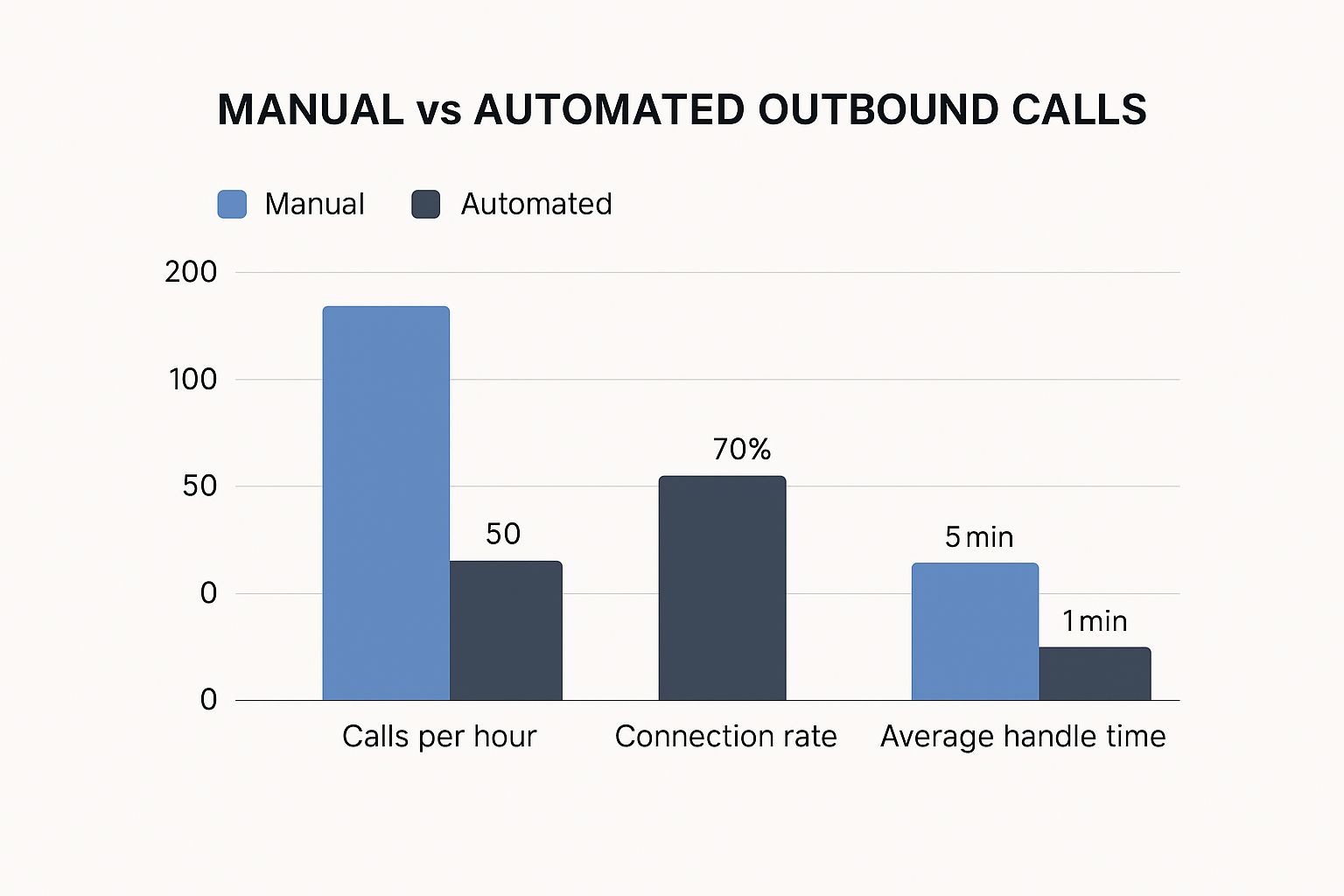How to Automate Outbound Calls for Better Sales Results
- Matthew Amann
- May 22
- 13 min read
The Reality of Outbound Call Automation Today

Outbound call automation has evolved significantly. It's no longer just about speed dialing. Instead, it represents a fundamental change in how businesses interact with their customers. This involves not just increased efficiency, but a complete reevaluation of the customer journey and how technology can strengthen relationships. Think personalized messages delivered at the perfect time, rather than generic scripts recited by robots.
The Shift Toward Intelligent Automation
Several key factors are driving this evolution. Advancements in Artificial Intelligence (AI) and Machine Learning (ML) allow systems to understand and respond to customer interactions with greater nuance. The increasing availability of data also offers valuable insights into customer behavior, preferences, and needs. This allows businesses to automate outbound calls in a more human and less robotic way. This personalized approach is essential for building trust and fostering stronger customer connections.
The market reflects this shift. Automation in outbound calling is growing rapidly, as shown by call center automation statistics. Gartner projected that the automation rate of agent interactions in contact centers will increase fivefold from 1.8% in 2022 to approximately 10% by 2026. This trend highlights the growing use of automated outbound communications powered by AI and machine learning.
The call tracking software market further illustrates this growth. This market, which supports outbound call analytics and optimization, grew from $8.84 billion in 2024 to a projected $9.82 billion in 2025, reflecting an 11% compound annual growth rate. Forecasts predict the market will reach $14.7 billion by 2029. This increase in call tracking and automation software adoption stems from the demand for features like real-time analytics, better ROI measurement, regulatory compliance, and improved customer experience through AI-powered features like voice recognition and multi-channel tracking. These advancements allow businesses worldwide to automate outbound calls effectively, freeing up agents from repetitive tasks and improving the quality of customer engagement. For a deeper dive into call center statistics, see this Sprinklr blog post.
Key Components of Effective Automated Systems
Effective outbound call automation today relies on the interplay of several key components:
Predictive Dialers: These systems intelligently dial numbers, filtering out busy signals and unanswered calls so agents connect only with live prospects.
CRM Integration: Integrating seamlessly with CRM systems enables personalized messaging tailored to individual customer data.
Voice Analytics: Analyzing call recordings offers valuable insights into customer sentiment and agent performance.
Natural Language Processing (NLP): This technology enables systems to understand and respond to human language, facilitating more natural and engaging conversations.
This integrated approach isn't just about digitizing outdated processes. It's about using technology to build a more effective and engaging experience for every customer.
Why Smart Businesses Automate Outbound Calls

The infographic above offers a clear comparison of manual and automated outbound calling performance across three key metrics: calls per hour, connection rate, and average handle time. The data reveals significant advantages with automation. Automated systems make four times more calls per hour, achieve a connection rate that's more than double manual efforts, and reduce average handle time by a factor of five. These impressive gains translate into substantial improvements in efficiency and productivity.
This boost in key performance indicators (KPIs) makes a compelling case for automating outbound calls. Imagine a sales team constantly battling to meet quotas, bogged down by the tedious process of manual dialing. Automation frees up sales representatives to focus on higher-value activities like engaging with prospects and closing deals. This not only increases productivity but also enables businesses to scale their outreach more effectively.
Increased Efficiency and Productivity
Automating outbound calls significantly improves overall efficiency. It's not just about increasing the volume of calls, but also about making each call more productive. Here are some key benefits:
Reduced Manual Effort: Agents no longer waste valuable time manually dialing and waiting for connections.
Improved Lead Qualification: Automation can filter out unqualified leads, so agents can concentrate on promising prospects.
Personalized Communication: Automated systems can deliver tailored messages based on customer data, improving engagement.
These improvements are crucial for businesses looking to optimize outbound call operations and maximize their return on investment (ROI). For more information, check out this guide on boosting sales with automation.
The Growth of Predictive Dialing
The growth of automated outbound calling is further fueled by AI-powered predictive dialing. A 2023 report projects the global predictive dialer software market to reach USD 12.2 billion by 2028, growing at a compound annual growth rate (CAGR) of over 30%. Predictive dialers utilize machine learning to optimize call pacing, minimizing agent idle time and maximizing productivity. Learn more about call center automation trends from Voicespin. This technology is essential for businesses aiming to scale their outbound sales and marketing globally. For specific use cases, explore Outbound Verticals.
Building a Strong Business Case for Automation
While the data and trends clearly point to the advantages of automating outbound calls, a successful business case requires more than just acknowledging the benefits. Here are some key considerations:
Quantifiable Metrics: Define clear KPIs, such as calls per hour, conversion rates, and cost per acquisition, to effectively measure the impact of automation.
Cost-Benefit Analysis: Conduct a thorough evaluation of implementation costs against the potential ROI to demonstrate the financial viability of the investment.
Stakeholder Alignment: Secure buy-in from key stakeholders by clearly communicating the benefits and addressing any potential concerns.
By taking a data-driven approach, businesses can construct a compelling argument for automating outbound calls and unlock the full potential of this technology.
To illustrate the potential ROI of automated outbound calling, let's examine a comparison table.
The following table compares key performance metrics between traditional manual outbound calling and modern automated systems.
Performance Metric | Manual Outbound Calling | Automated Outbound Calling | Improvement Percentage |
|---|---|---|---|
Calls Per Hour | 20 | 80 | 300% |
Connection Rate | 15% | 35% | 133% |
Average Handle Time (minutes) | 5 | 1 | 400% |
This table clearly demonstrates the significant improvements possible with automated outbound calling. While manual calling may yield lower initial investment costs, the long-term gains in efficiency and productivity offered by automation translate to a higher ROI.
The Technology Powering Modern Call Automation

Modern outbound call automation is powered by a suite of technologies far more advanced than the basic auto-dialers of the past. These advancements enable businesses to automate outbound calls not only for increased efficiency, but also for personalized and intelligent customer interactions. Understanding these technologies is key to selecting the right solution for your specific business needs.
Predictive Dialers: Enhanced Agent Efficiency
At the heart of this technology is the predictive dialer. This system surpasses simple auto-dialing by employing algorithms to anticipate agent availability and dial numbers accordingly. This minimizes agent downtime spent waiting for connections, drastically increasing the number of live conversations they can handle. This is especially valuable for high-volume outbound call centers where maximizing agent productivity is paramount.
Voice Analytics: Uncovering Valuable Data
Voice analytics offers deep insights into customer conversations. By analyzing recorded calls, this technology identifies keywords, customer sentiment, and other critical data points. This data can be used to refine agent training, optimize scripts for better engagement, and even pinpoint emerging customer trends. For instance, if voice analytics consistently reveals customer frustration with a specific product feature, this can indicate a need for improvement or clarification.
Natural Language Processing (NLP): Creating Conversational Experiences
Natural Language Processing (NLP) plays a critical role in making automated conversations sound more human. NLP allows systems to both comprehend and respond to human language, leading to more natural and engaging interactions. This goes beyond basic pre-recorded messages, allowing for dynamic conversations that respond to customer input. This technology allows businesses to design automated calls that sound less robotic and foster better connections with customers.
CRM Integration: Tailoring the Customer Journey
Integrating your call automation system with your Customer Relationship Management (CRM) platform is essential for personalized customer interactions. CRM integration allows access to customer data like past purchases, interactions, and preferences. This empowers automated systems to tailor messages and offers to each individual customer, increasing the relevance and effectiveness of each interaction. This personalized approach can strengthen customer relationships and boost conversion rates.
To understand how these technologies compare, let's look at the table below:
Outbound Call Automation Technologies Comparison An analysis of different automation technologies with their features, benefits, and ideal use cases
Technology Type | Key Features | Best For | Implementation Complexity | Typical Cost Range |
|---|---|---|---|---|
Predictive Dialer | Algorithmic dialing based on agent availability, minimizes agent idle time | High-volume outbound sales and marketing | Moderate | 50 - 200 per agent/month |
Voice Analytics | Keyword spotting, sentiment analysis, conversation transcription | Improving agent performance, understanding customer needs | Moderate to High | 100 - 500 per seat/month |
Natural Language Processing (NLP) | Enables natural, dynamic conversations based on customer input | Creating engaging automated conversations, virtual assistants | High | Varies widely based on complexity |
CRM Integration | Accesses customer data for personalized messaging and offers | Tailoring customer interactions, improving conversion rates | Moderate | Included with many CRM platforms or available as add-ons |
This table highlights the key differences between each technology, allowing businesses to make informed decisions about which solutions best suit their needs. While predictive dialers focus on efficiency, NLP concentrates on creating a human-like experience. Voice analytics and CRM integration offer valuable insights and personalization capabilities, respectively.
Emerging Technologies and the Future of Automation
Beyond these core technologies, emerging trends continue to reshape automated outbound calls. These include advanced sentiment analysis, real-time call transcription, and integrations with other communication channels such as automated text messages. These advancements will further enhance the effectiveness and sophistication of automated outbound calling systems. For businesses exploring workflow automation, platforms like Zapier, Make.com, and N8n offer powerful integration options. For strategic automation consulting and implementation, consider a specialized service like Flow Genius, particularly if your business operates within the infrastructure, technology, energy, logistics, construction, or commercial cleaning industries. Flow Genius designs and deploys custom workflows that optimize resource allocation, supply chain oversight, data analytics, and client interactions, helping your business achieve scalable growth through intelligent automation. By understanding the interplay of these technologies, businesses can effectively evaluate solutions and implement automated outbound calling strategies that deliver tangible results.
From Decision to Deployment: Implementing Call Automation
Automating your outbound calls isn't something you can achieve overnight. It's a process that demands careful planning, precise execution, and continuous optimization. Much like constructing a house requires blueprints and a phased approach, implementing call automation necessitates a structured strategy.
Building Your Implementation Team
The first step is to assemble a cross-functional team. This team should comprise representatives from sales, marketing, IT, and customer service. Including members from these diverse departments ensures a holistic perspective, incorporating insights from front-line users as well as technical specialists. This collaborative approach minimizes potential obstacles and streamlines the implementation process. For instance, involving sales representatives from the outset allows them to offer valuable input on how automation can best support their daily workflow.
Defining Clear Goals and Objectives
Next, establish clear objectives. Ask yourself what you aim to accomplish with call automation. Are you striving for increased sales, improved customer satisfaction, or reduced operational costs? Defining specific, measurable goals allows you to track progress, make necessary adjustments, and demonstrate the value of automation to stakeholders.
Choosing the Right Technology
Selecting the right technology is paramount. Consider your unique business needs and opt for a solution that aligns with your goals and budget. Do your requirements call for basic auto-dialing, or would a more advanced AI-powered system be more beneficial? Factors like the size of your team, your call volume, and your integration requirements will influence your decision. A small business with a limited budget may choose a simple predictive dialer, while a large corporation might invest in a more robust platform with advanced features like NLP and voice analytics.
Modern call automation often incorporates various technologies, such as automated messaging. You can learn more about this in articles like Transform Communication: Automated Text Messages Guide.
Training Your Team and Redesigning Processes
Thorough agent training is crucial for successful implementation. Your team must understand how to effectively use the new technology and how it integrates into their redesigned workflows. Providing adequate training and support is essential for maximizing the benefits of automation. Additionally, existing processes may require adjustments to accommodate the new automated system. For deeper insights into process automation, consult resources like How Automation Can Streamline Your Project Management.
Piloting, Scaling, and Optimizing
Begin with a pilot program. This allows you to test the system in a controlled setting and identify any potential problems before a full-scale deployment. Once the pilot proves successful, you can gradually scale up the implementation across different teams or departments. Ongoing optimization is essential. Monitor performance metrics, gather feedback from your team, and make adjustments as needed to ensure your automation strategy consistently delivers positive results. This iterative approach guarantees continuous improvement and adaptation to the evolving needs of your business and customers.
Data-Driven Calling: Automation in the Intelligence Era

The outbound calling landscape is changing. The focus is shifting from high volume to high quality. Successful businesses are now leveraging data and AI to personalize their outreach. They aim to connect with the right leads at the right time. This transforms outbound calling from an interruption to a valuable interaction.
The Power of Personalized Outreach
Data-driven automation allows for a level of personalization not possible with manual calling. Imagine accessing a customer’s browsing history, email interactions, and past purchases before a call. This information helps tailor your message to their specific needs. As a result, you will see increased engagement and higher conversion rates.
For example, if a customer abandons their online shopping cart, an automated call could remind them. It could also offer assistance to complete the purchase. This targeted approach is more effective than a generic sales pitch. You might be interested in reading more about Efficient Customer Engagement.
Integrating Multiple Data Sources for Maximum Impact
Leading organizations integrate various data sources. They aim to create a comprehensive view of each customer. This includes data from CRM systems like Salesforce, website analytics tools like Google Analytics, social media, and even offline interactions. Combining these data points builds detailed customer profiles. These profiles then inform personalized outreach strategies.
This integration allows for sophisticated segmentation. Instead of broad demographics, you can create highly specific segments. These are based on behaviors, preferences, and purchase history. This allows you to deliver the right message, to the right person, at the right time.
Optimizing Calling Windows and Predicting the Perfect Moment
Timing is everything in outbound calling. Data-driven automation helps optimize calling windows. It uses individual customer preferences and behavior patterns. This increases the chance of connecting with a receptive audience. It also improves overall customer satisfaction.
AI-powered systems can predict the best time to call a specific customer. By analyzing historical data and patterns, these systems suggest optimal calling times. This maximizes connection rates and minimizes wasted effort, ultimately improving efficiency and ROI.
The use of automation for outbound calls is growing. By 2025, outbound calling is expected to be a data-driven process. Advanced platforms now integrate comprehensive customer analytics. You can learn more about the evolution of outbound calling. This data includes website visits, email opt-ins, and social media engagement. It also includes historical purchase and call records. This enables better lead prioritization and personalized calls, leading to improved conversion rates. Remote work combined with AI-enabled calling has also reduced operational costs.
Ethical Considerations and Data Privacy
Data-driven automation offers many benefits. However, businesses must address ethical considerations around data usage. Data privacy and transparency should be prioritized. Customers should be informed about how their data is used. They should also control their communication preferences.
Clear data governance policies and adherence to regulations build trust. This ethical approach is essential for long-term success in data-driven calling.
The Human Factor: Automation That Strengthens Connections
Outbound call automation offers incredible potential for boosting efficiency. However, connecting with customers requires more than simply streamlining processes. It requires a genuine human touch. This section explores how successful organizations find the right balance between technological advancements and the essential human element in their outbound call strategies.
Balancing Automation with Authentic Human Interaction
Automating routine tasks like dialing and scheduling frees up agents to focus on more complex customer interactions. However, some aspects of the customer journey benefit significantly from a human touch. Consider a customer with a complicated issue or one who needs personalized advice. A pre-recorded message or a chatbot simply can't provide the same level of empathy and understanding as a trained agent. Therefore, strategically choosing which processes to automate is vital.
Automated systems excel at delivering appointment reminders or collecting feedback. Handling sensitive customer complaints or building rapport with key clients, however, often requires human interaction. Finding this balance maximizes efficiency while preserving the human element crucial for building strong customer relationships.
Hybrid Workflows: Combining AI and Human Expertise
The most effective approach often involves hybrid workflows, combining the strengths of AI-powered automation with human judgment. Think of it as a well-coordinated team: AI handles initial tasks, like qualifying leads and scheduling calls, while human agents step in for more complex conversations and relationship building.
This collaboration allows agents to focus on higher-value activities that require empathy and problem-solving skills. AI handles the repetitive tasks, leading to increased overall efficiency and a more satisfying experience for both agents and customers.
Training Agents for the Automated Age
Successfully implementing this hybrid approach requires preparing your team. Agents need training not only on using new automated systems but also on collaborating effectively with them. This includes understanding how AI handles initial interactions, how to interpret data provided by AI systems, and when to seamlessly take over from the automated process.
This new approach means training agents to become active listeners, adept problem-solvers, and empathetic communicators. These skills are even more crucial as human agents become responsible for managing the more nuanced aspects of customer interactions.
Crafting Natural-Sounding Scripts for AI Interactions
The human factor extends beyond live agent interactions. Even automated messages need to sound natural and engaging. Carefully crafted scripts that reflect your brand’s voice and resonate with your target audience are essential. Think of automated messages as an extension of your brand identity, ensuring that even these automated touchpoints contribute to a positive customer experience.
This also involves ensuring smooth and seamless handoffs between automated systems and human agents. Customers should not feel like they are being passed between a robot and a person. The transition should be so natural that it strengthens, not weakens, the connection. This involves clear communication, shared context between the system and the agent, and personalized interactions that demonstrate a genuine understanding of the customer’s needs. Leading brands have increased customer satisfaction scores while scaling operations through thoughtful automation, focusing on enhancing, not replacing, human connections. This demonstrates that automation, when implemented strategically, can improve not only efficiency but also the overall customer experience.
Future-Proofing Your Outbound Automation Strategy
As customer behaviors and technologies evolve, maintaining an effective outbound automation strategy requires adaptability and foresight. This means continually evaluating your system, integrating new capabilities, and anticipating future trends. This section explores key strategies for future-proofing your outbound automation efforts and ensuring long-term success.
Embracing Emerging Technologies
The future of outbound automation lies in integrating new technologies. Advanced sentiment analysis, for example, goes beyond basic keyword spotting. It delves into the nuances of human emotion to gauge true customer sentiment. This deeper understanding allows for more personalized and empathetic responses, improving customer satisfaction.
Real-time call transcription offers another powerful tool. By converting spoken words into text instantly, businesses can analyze conversations, identify trends, and improve agent training. This technology allows for immediate feedback and adjustment during calls, leading to better outcomes.
Integrating outbound calls with other communication channels, such as automated text messages, creates a more cohesive customer journey. This omnichannel approach recognizes that customers interact with businesses across multiple platforms. Providing a seamless experience across all touchpoints is critical for sustained success.
Building Adaptable Systems
A future-proof strategy requires flexible systems. Think of it as building with Lego blocks – easily adaptable to changing needs. Modular systems allow you to add or remove features based on evolving requirements. This agility is crucial for staying ahead of the curve and responding quickly to market changes.
Choosing automation solutions with robust APIs and integration capabilities is also essential. Think of APIs as connectors that allow different systems to communicate. These integrations enable you to share data and functionality between your call automation platform and other critical business tools, such as your CRM or marketing automation software.
Continuous Optimization and Feedback Loops
A future-proof strategy isn't static; it's dynamic. Implement systems that track performance metrics and collect user feedback. Regularly reviewing this data identifies areas for improvement, allowing you to adapt to changes in customer behavior and refine your approach.
This involves establishing clear KPIs and regularly monitoring progress. Are your connection rates improving? Are your conversion rates rising? Analyzing these metrics helps pinpoint bottlenecks and opportunities for optimization. Don't be afraid to experiment with different approaches and continually refine your strategy based on data and feedback.
Navigating Regulatory Changes and Consumer Expectations
The regulatory environment around data privacy and communication is constantly evolving. Staying informed about new regulations and ensuring your automation strategy remains compliant is crucial. This proactive approach avoids potential legal issues and maintains customer trust.
Consumer expectations are also constantly shifting. Today’s customers demand personalized, convenient, and efficient interactions. Your outbound automation strategy must adapt to these changing expectations to deliver a positive customer experience. This customer-centric approach builds loyalty and strengthens your brand reputation.
By prioritizing adaptability, integrating new technologies, and maintaining a focus on the human element, you can future-proof your outbound automation strategy and build a system that delivers sustainable results in an ever-changing business environment.
Ready to eliminate manual processes and unlock scalable growth for your business? Learn more about Flow Genius and discover how our smart automation solutions can transform your operations.